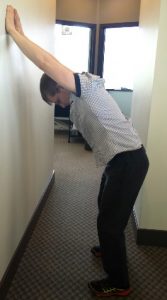Stretch: To draw out or extend to full length. (Taber’s Cyclopedic Medical Dictionary 18th Ed.)
Stretching is a form of physical exercise in which a specific muscle or muscle group is deliberately stretched in order to improve the muscle’s elasticity, flexibility, range of motion and achieve comfortable muscle tone. Stretching can also lead to a better posture, fewer aches and pains as well as increased blood circulation.
Before performing a stretch, make sure you do it safely and effectively. While you can stretch anytime, anywhere — in your home, at work, in a hotel room or at the park — you want to be sure to use proper technique and biomechanics. Stretching can be dangerous when performed incorrectly. Do not stretch if you are injured without the help of a physical therapist. Doing so may result in further injury. Also, don’t think that because you stretch you can’t get injured. Stretching, for instance, won’t prevent an overuse injury. Talk to your doctor or physical therapist about the best way to stretch if you have any health concerns.
Don’t consider stretching a warm-up. You may hurt yourself if you stretch cold muscles. So before stretching, warm up with light walking, jogging or biking at low intensity for five to 10 minutes. Or better yet, stretch after you exercise when your muscles are warmed up. Also, consider holding off on stretching before an intense activity, such as sprinting or track and field activities. Some research suggests that pre-event stretching before these types of events may actually decrease performance.
Focus of the Stretch. When you’re stretching, focus on your calves, thighs, hips, lower back, neck and shoulders. Also stretch muscles and joints that you routinely use at work or play. And make sure that you stretch both sides. For instance, if you stretch your left hamstring, be sure to stretch your right hamstring, as well.
Don’t bounce. Bouncing as you stretch can cause small tears in the muscle. These tears leave scar tissue as the muscle heals, which tightens the muscle even further, making you less flexible and more prone to pain. So, hold each stretch for about 30 – 45 seconds.
Don’t aim for pain. Expect to feel tension while you’re stretching, not pain. If it hurts, you’ve pushed too far. Back off to the point where you don’t feel any pain, then hold the stretch.
Keep up with your stretching. Stretching can be time-consuming. But you can achieve the best benefits by stretching regularly, at least two to three times a week. If you don’t stretch regularly, you risk losing any benefits that stretching offered. For instance, if stretching helped you increase your range of motion, and you stop stretching, your range of motion may decrease again.
To get your joints mobilized and restore motion, feel relaxed and rejuvenated, book an appointment today with Chiropractic or Massage Therapy at Backs in Action Wellness Centre!


